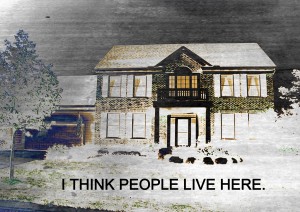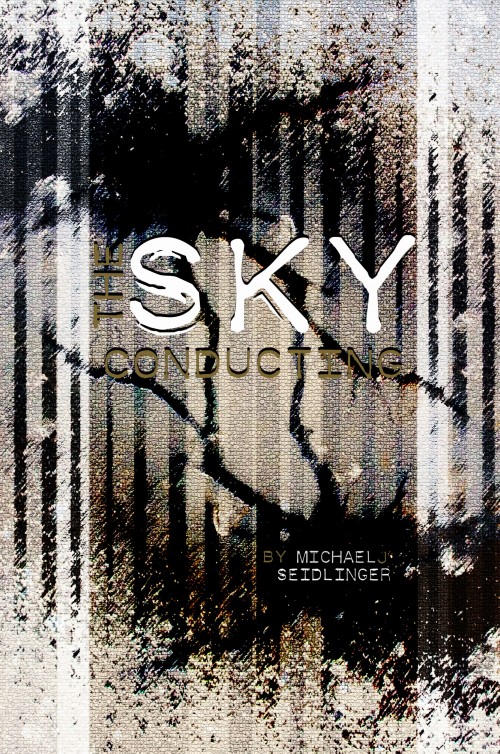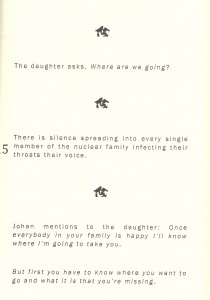Author Spotlight
“America is an artifact”: Michael Seidlinger gets interviewed by me about his new book
HIGGS: One of the first things one encounters in The Sky Conducting is a brief description of the form of the text and instructions on how to read it. Could you talk a little bit about your choice to open the book this way?
SEIDLINGER: Looking back at it now, I worry some people might take the instructions literally. But then again, I should probably have more faith in the humanity; no one would be stupid enough to actually follow those instructions, right? In the event that the reader heeded the instructions, s/he would quickly tire of it. Hmm… Maybe the book should have a sticker affixed to its cover, “Warning: You Need to Keep Breathing to Live” or “Warning: Not Enough Oxygen to the Brain May Induce Stroke.”
I wrote out the instructions to help clarify the book’s use of negative/blank space. The instructions came to life from a personal need to give some kind of reason, something other than “this looks cool,” to the style and typesetting of the book. The actual inhale/exhale breathing manner is made to be so absurd that it’s obvious that it would be impossible read the book while frequently holding your breath. In this way, the instructions are there purely for aesthetic reasons.
HIGGS: Ah, that goes to show I have no sense of humor! It is a fault of mine: as a reader I tend to take everything deadly serious. For me, the breathing instructions harkened to Ben Marcus’s Notable American Women, and it also called to mind Ginsberg’s comment that “Ideally each line of ‘Howl’ is [meant to be read as] a single breath unit.” But your anxiety about needing to justify the form of your book is interesting to me. Could you say more about that? Are you opposed to the idea of art for art’s sake, or…?
SEIDLINGER: You and me both. I am often criticized as either having a very dry sense of humor or no sense of humor at all. When people joke around, my immediate reaction is usually to process something as-is and give reply; it causes a lot of people to follow-up by trying to clarify the intentions of their quip or joke. Oh well, I’m also unable to ever relax, so that might be part of it. Go figure. It only takes a few drinks to loosen up anyway.
I remember when the structure of the book started to fall into place. I was really worried about what was happening. I set out to write in a standard prose format but found that I kept starting new lines after every sentence. No sentence wanted to be attached to each other. The book started forming, structurally, into a long verse-poem of sorts and I felt like I was losing control of its “shape.” This is where I started stitching lines into what I term as “groupings” within the “faux-instructions” of the book. It was my way of maintaining coherence and consistency in the absence of a more traditional prose format. In a way, it arose from an act of quick-thinking and anxiety spawning from going into writer “damage control.” Once I let go, putting the lines together as need by in these really loose groupings, the piece felt like it could breathe. This is where the whole “Breathing Manner” subsequently received its namesake and aesthetic. With the lines grouped thusly, it felt like the blankness of the page created its own sense of gravity. It felt like the essential elements of nature escaping, creating a void where the lines could float there, suspended, waiting to be read.
HIGGS: America is central to the book — I dare say it aspires to be a “Great American Novel,” but in a very smart and interesting 21st century way — so I’m curious to hear more about your perspective on America: the place, the concept, the dream, and perhaps why it took center stage for you in this book.
SEIDLINGER: I feel like there’s no clear perspective on America. Not anymore. From a personal level, when I try to conjure American imagery, values, and/or ideals I’m left with a scattered cloud of imagery:
Being American has quickly devolved from idealism to something more anomalous. We still see American pride in its more declarative, judicial and commercial forms but that sense of pride is beginning to appear blatantly false. The whole “American Dream” concept is now everyday fodder. Americans love to complain and first up for use are the seemingly endless ironies, fallacies, and all-encompassing doom that come with the whole American Dream concept. It’s becoming more and more impossible for the younger generations to be able to afford their own houses in the suburbs with 2.5 children, a pet or two, new cars, decent up-to-date furniture and so forth. For the general twenty-something, their residence is most likely shared with roommates. It’s most likely an apartment or one of those houses with the unkempt lawn and a crowded driveway. I almost want to say it would be easier to ask someone who isn’t American about “being American” than an actual American. We’re all so easily stressed with the small things; we’re all so confused. When it comes right down to it, “America” might be best defined as confusion. “The land of the freely confused.”
HIGGS: That reminds me of the section on page 137 when you write, “Americans are cute. They are so scared of the world. Americans never knew how much the world was afraid of Americans.” In many ways, I think The Sky Conducting could be read as social commentary, but I worry about the heaviness attached to such a description. I think you succeed in disallowing the heaviness to overtake the text, but it seems like one hell of a balancing act. Could you say a little bit about how you envision the relationship between fiction and social commentary in the book?
SEIDLINGER: I feel like most fiction, whether the author intends to or not, provides its own degree of commentary. Some pieces are more political, more self-centered than others; some pieces open up the floodgates with all sorts of philosophy. Way back when, sci-fi was criticized for being inferior to literature; however, we know now that authors like Stanislaw Lem, Philip K Dick, and John Brunner operated in the genre of sci-fi. The work they provided some of the best socio-cultural commentary. It’s a personal preference, really, but I do believe everything is written to be a statement.
With regards to The Sky Conducting, the need to comment and consider American culture in retrospect fueled the narrative and vice versa. It started out with an image of a street corner at night, shielded by a heavy mist. Jutting out of the mist, a Walgreens marquee could be seen advertising sales on toilet paper, soda, and other menial products. The image held on that for a moment and panned out to reveal people walking away from something. I didn’t know what they were fleeing. It turns out they were fleeing America. The biggest question is “why,” and that’s where it all began. Almost instantly I began exploring American popular culture and values. I remember writing out a list of aphorisms commonly used within informal conversation. I knew I had to incorporate materialism. That’s where the artifact/bartering system got its start. The need to explore the social fabric helped provide the necessary amount of direction for the narrative.
 HIGGS: I think readers will no doubt identify as significant the connection between family, nation, and home. What do you find so interesting about that triangle?
HIGGS: I think readers will no doubt identify as significant the connection between family, nation, and home. What do you find so interesting about that triangle?
SEIDLINGER: It might be considered a trinity of sorts, the base of a “support network.” Home spawns concepts of family. A nation is assumed to be a series of ever-expanding families and homes, a community of sorts. They are synonymous with each other. As well, American family life is one of the most fervent of American ideals. If there’s some social issue being discussed, you can bet in some way, shape, and form “the American family” is intertwined into the politics of the issue. What’s so compelling about the family concept is that it can be equated to every single aspect of the creation of the American citizen and American individual. Whatever way it is viewed, the family acts as a set of standards from which we conduct ourselves. It’s where we are born, grown, and aspire to leave. Eventually it becomes the place we miss, the place we try to recreate with ourselves as the master/head of the household. A big part of being American is the ability to showcase your independence. If you can’t support yourself, expect to be judged harshly by all.
HIGGS: Towards the end of the book, on page 279, you write:
The daughter looks away from Johan suddenly unable to face his sincere eyes. She says, There isn’t a lot for a person like me a person my age to do in this country.
But this was a land of opportunity, Johan protests.
The daughter shook her head, Opportunities fit in two plain and simplistic categories.
Dreams aren’t one of them.
I love that exchange, because for me it speaks so sharply to many of the interconnected issues in The Sky Conducting: sincerity, desire, dreams, reality, and so on. The other thing it does, as a microcosmic illustration of the macrocosmic, is veil itself in mystery…what are the two plain and simplistic categories, and why are dreams and opportunity mutually exclusive?
SEIDLINGER: I feel like most opportunities can be placed in two categories:
1) Funding
2) Footing
A perfect opportunity fits into both categories. Opportunities are those occasions and instances where an individual is able to advance themselves. The advancement is prototypically in wages/fiscal earnings and social status. If a person is looking for an opportunity to spiritually advance themselves, they’re going to have a difficult time finding it without losing Funding and/or Footing. Dreams are the kinds of things that are typically less defined, more personal, more existential. They involve a kind of desire that cannot be easily placed within the “plentiful” opportunities in America. An individual typically chases something that fails (at least initially) to fit either category. This Dream devours those two categories. The individual will likely lose footing – be it a loss of favor, friendships, and so forth. No doubt, the individual will have to invest funds into the act of chasing the Dream. The irony exists in the fact that Dreams don’t fit into the two essential categories; Dreams also that Funding and Footing are already possessed. The more plentiful the better, the easier it will be to capture the Dream. How many of us actually have the Funding and the Footing to “go for it?”
HIGGS: What would you say to someone who suggested that The Sky Conducting was a dystopian novel?
SEIDLINGER: I’d say that’s pretty accurate. A piece dealing with factors of society ought to be classified as dystopian. As we all clearly see every day, there has yet to be a nation that “got it right.” Everywhere we look, there are deeply imbedded issues and conflicts. It’s evident there can be no perfect society. Society is inherently dystopian. Only in strict fantasy do we envision a utopia. Even then, the utopia is almost always missing a measure or two of vibrancy, dynamism, the verve that comes with real life.
HIGGS: If there were a soundtrack for the book, what would be on it?
SEIDLINGER: It would contain a lot of white noise punctuated by the echoed sounds of footsteps, cackling… maybe a little piano in the distance… a lone musician on an unturned acoustic guitar playing American anthems in solemn retrospect. Empty landscapes breathing, sighing.
A lot of post-rock would fit this piece. Explosions in the Sky. The American Dollar. This Will Destroy You. Collapse Under the Empire.
Post-rock captures the atmosphere of a living, breathing, suffering society; the kind of atmosphere that inspires and suffocates us.
HIGGS: I’m curious about the image that separates each section, which you describe in the book as “that solemn, falling icon of the American home.” To me it sort of looks like a mini Rorschach blotting with a crucifix in the middle. Am I close? Or, put it another way, what’s the deal with that icon?
SEIDLINGER: This definitely feeds back into the discussion about the instructions and the book’s structure. On the surface, the icon is used to separate a scene, a conversation, a single nugget or event from other events. It gives semblance through categorization and provides a sort of rolling linearity to what might not have been as rhythmic without it. Going below that, the icon is meant to repeat, or haunt, the nuclear family’s path. Family is something.
Everywhere they go, the element of family is there, haunting them. It also guides them, continually provides both conflict and support. It’s suggested that without family there would be nothing – a void.
The image/icon of a home is a representation of family. Family is something which, like it or not, sticks with you. The daughter develops all sorts of escape plans dreaming of the day when she can run away from the family but it’s pretty clear that she can’t, she won’t, and she never will.
It’s very cool to get the Rorschach comparison. I created the icon in Photoshop using one box shape, one triangle shape, going at it with the eraser tool, and a few filters. The icon was made to be just that – abstracted enough but vaguely the shape of a house. It is also ghost-like, as if the nuclear family and reader are looking into something that gives as much the amount of effort you put in.
HIGGS: What other books do you see as being in conversation with The Sky Conducting?
SEIDLINGER: It was funny that you mentioned Ben Marcus earlier because I really do feel his latest work, The Flame Alphabet (amazing, really amazing book by the way), would fit in the same dystopian/social commentary conversation. The Road by Cormac McCarthy as well.
 I actually put in a sort of easter-egg into The Sky Conducting. Early in the novel, the daughter has a few dreams involving the burning down of the home. Within the dreams, there is an implied reference to Cormac McCarthy’s The Road. The father and son show themselves, if only for a single line.
I actually put in a sort of easter-egg into The Sky Conducting. Early in the novel, the daughter has a few dreams involving the burning down of the home. Within the dreams, there is an implied reference to Cormac McCarthy’s The Road. The father and son show themselves, if only for a single line.
I mentioned John Brunner before; his novel The Sheep Look Up deals with similar dystopian themes, mostly about the human race’s ignorance and negligence towards nature and its surroundings.
It’s kind of strange really. The more you explore the dystopian genre, the more you realize that the vast majority of this kind of fiction can be read as one whole body of work. They all comment on central issues to society, individuality, and our placement and power (or lack thereof) on this earth. Dystopian fiction is equal parts indulgence into destruction as it is expression of social/cultural peril.
HIGGS: Okay, final question. As you know, I am particularly interested in works of experimental literature. Given that the publisher you’re working with is Civil Coping Mechanisms, which advertises on their website as publishers of “innovative fiction,” I am eager to hear your perspective on these terms and perhaps how you see The Sky Conducting as innovative / experimental.
SEIDLINGER: The “What is Experimental Literature?” series you spearheaded a little while back was really interesting stuff. It’s kind of baffling to see how experimental literature is so hard to plainly describe. Everyone has their own definition of experimental literature. It’s my guess that the inherent nature of experimental literature is to forego any strict categorizations. I mean, when someone mentions poetry, or a poem, the general reader has a fairly accurate definition of what to expect. Same goes for a lot of nonfiction and contemporary fiction. We know what we’re getting when we buy a crime thriller or someone rockstar’s biography. Depending on the person, hearing the term “experimental literature” will bring about a wide-range of reactions and expectations.
Experimental literature imbeds a level of defiance. Picking up something dubbed experimental… you don’t really know what to expect. It’s not always a good thing and a lot of people are intimidated by the experimental literature designation. It’s unfortunate. The literary community really needs to continue exploring this topic… I’m getting sidetracked, lost in so many conflicting examples, just trying to answer with a little bit of a wider overview. The one thing I can see in everything deemed experimental literature is this sense of individuality.
Trying for a straight-comment/definition, I’d say that experimental literature is a category of literature where the structure of a piece takes on its own life.
And yeah, The Sky Conducting is experimental. Flipping through the book, it’s easy to notice how very little of the page is filled. Most of the page is blank space. That aspect, alongside the “Breathing Manner,” and the use of the House icon, places The Sky Conducting in the big bad category of experimental literature.



Cool interview, guys.
Thanks Scott!
not knowing if something is american or not is american.
Dig this.
Thanks Ken!
Precisely my point. It becomes tough with “American” becoming such an anomalous term. Everyone has their own, but when comparing there are a splintering array of differences.
Excited to read this. Thanks for conducting an interview.
Thanks! Looking forward to hearing your thoughts about the book.